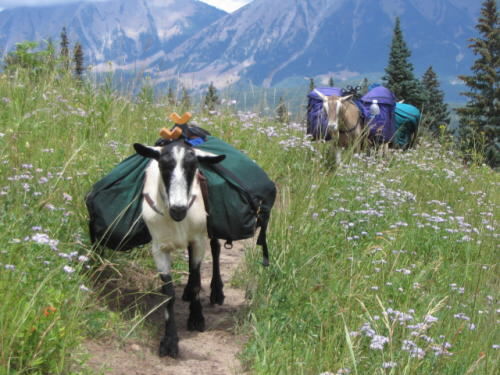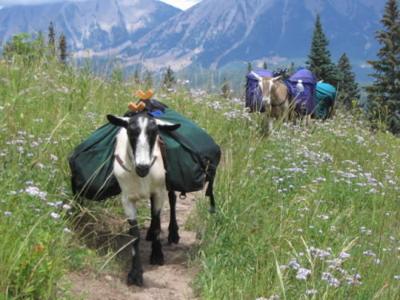Pete is almost the perfect hiking companion. He’ll carry my gear, walk for miles without complaining and keep me company on the trail. And when I’m not looking, he’ll eat my lunch. And my lunch bag. And my map.
Pete is a goat, after all, and he does what goats do: walk nimbly on uneven terrain, follow the group without complaint and nibble on pine needles, bark and bushes whenever he feels the urge — and on hikers’ supplies whenever he can get away with it.
Pete is one of two goats owned by Mary Wolf, a real estate agent from Centennial who discovered the joys of goat packing on a trip more than a decade ago. She has since hiked thousands of miles with her fuzzy companions. On this hot, dry Saturday morning, Wolf and her goat-packing partner and friend, Carol McCoy, are leading a group of adults, children and goats along a part of the Continental Divide Trail near Breckenridge. The trail begins on Tiger Road off Highway 9 and heads up through a cool forest of lodgepole pine.
The start is a little shaky as Wolf and McCoy adjust their goats’ loads and the animals struggle to find their places in the line. On this trip, Pete is the veteran. Weighing in at about 200 pounds, he is the largest and arguably most intimidating of the group, with flashing yellow eyes, metal-colored horns and a gray beard that dangles from his chin. In the goat world, Pete isn’t an old man, but at 8, he is one of the elders in this group, which includes three wide-eyed siblings, owned by McCoy, on their first trail adventure.
GETTING STARTED GOAT PACKING
Wolf and McCoy started goat packing together in 1992. They met several years before that, joined by a common love of horses and trail riding.
“We were talking one time and I told Carol I wanted to do the Colorado Trail,” Wolf says. “She said she did, too, so we took some packing classes and packed horses and mules the first couple of years.”
But horse packing was difficult for the two women.
“A horse carries about 75 pounds on each side of its pack, and it’s really hard getting that load up there,” Wolf says.
McCoy discovered a book about goat packing — John Mionczynski’s “The Pack Goat” — and gave it to Wolf.
“I read it and said, ‘Where do we sign up?’” Wolf says.
Goat packing offered the two friends all the benefits of packing with horses or llamas, but with fewer problems.
“It was easier to walk and take a goat than it was to ride a horse,” Wolf says. “With a horse you have to find water and pasture. With a goat, you can stop anywhere.”
Goats are related to cows and antelope and are particularly suited to hiking Colorado’s rocky trails and high elevations. They can go for days without water, graze on anything and are sure-footed on steep hillsides and rocky paths.

Peanut, left, and Rooster carry packs for owner Steve Galchutt, whose bad knees limit the weight he can carry.
HEAD OF THE HERD
On the trail winding above Breckenridge, the goats demonstrate their pecking order. Domino, the oldest goat, has explored 200 miles of the Colorado Trail and is always the leader, piloting goats and humans up the trail without hesitation. Belinda is what Wolf calls the group’s social director. She worries her way along the route, running ahead to check Domino’s position, backtracking to make sure the kids — all novice hikers — keep with the group and bleating her disapproval when the group gets unwieldy. Pete is the renegade. The biggest goat on the trail, he checks out all the people, pushes his way in front of others, cuts switchbacks at will and stops to munch on trees.
Wolf says the key to training goats to pack is to start them when they are kids, bottle-feeding them so they form a bond with their owner.
“Domino was on the Colorado Trail with us when he was 4 months old. We had two that were that age, and we called them our garbage goats.”
The women put tiny packs on the goats for that trip and as they hiked, they would fill the packs with garbage they found on the trail. Wolf and McCoy have taken as many as six goats on a trip.
“They carry our tents and sleeping bags. We each have a personal goat and a kitchen goat and maybe a couple of babies.”
Because the goats have bonded with the women, Wolf says they never wander and don’t have to be led. She has walked thousands of miles with goats and she says they’ll always follow. In her years of owning and packing with goats, Wolf says there was just one who wouldn’t hit the trail.
“For some reason, he would just lie down and wouldn’t go with the group. He just wouldn’t hike. He ended up in the freezer.”
FIBROUS FOODIES
Getting Pete and his hiking companions to move along isn’t a problem. As they leave the lodgepole forest and emerge into a lush green meadow, they pick up their pace. A couple on their way down the trail stop to check out the unusual collection of adults, children and goats.
“There are some great wildflowers ahead,” the woman says. “Blue columbine and dozens of others — at least there were,” she adds as she glances at the goats uneasily.
Wolf and McCoy smile and reassure the hikers that goats prefer fibrous food to tender grass and wildflowers. At a lunch stop in the meadow, Pete and Domino prove them right, checking out the green understory, then munching on mouthfuls of pine needles. And my lunch bag.
GOAT TRIVIA
ABOUT GOATS
HOW TO GET YOUR GOAT
The best way to get a goat for packing your stuff is to raise your own. The goat packers in this story don’t rent out their goats or guide goat-packing trips. They organized this trip for the Continental Divide Trail Alliance 10th anniversary.
Wind River Pack Goats in Lander, Wyo., offers guided goat-packing trips. Visit www.goatpacking.com or 1-707-442-3209.
For more information on packing with goats, visit www.highuintapackgoats.com and goattracksmagazine.com and Summit Pack Goat.









(0) comments
Welcome to the discussion.
Log In
Keep it Clean. Please avoid obscene, vulgar, lewd, racist or sexually-oriented language.
PLEASE TURN OFF YOUR CAPS LOCK.
Don't Threaten. Threats of harming another person will not be tolerated.
Be Truthful. Don't knowingly lie about anyone or anything.
Be Nice. No racism, sexism or any sort of -ism that is degrading to another person.
Be Proactive. Use the 'Report' link on each comment to let us know of abusive posts.
Share with Us. We'd love to hear eyewitness accounts, the history behind an article.